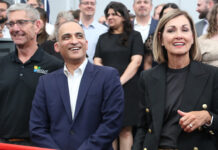By Cindy Hadish
CEDAR RAPIDS – The city’s medical district has a clearer vision of its future with a new report that outlines preliminary goals and objectives, but still has much to accomplish before becoming a national destination.
“The ideas we’re testing are big ideas because we want this to be a special place,” Scott Freres, president of the Lakota Group, said during an Oct. 24 public forum at St. Luke’s Hospital to gather input based on the new State of the District report. “We’re thinking of you on the national scale.”
The Chicago-based firm was hired to develop a master development plan for the 55-block district centered between St. Luke’s and Mercy Medical Center, known as MedQuarter.
That master plan could come in early 2014, said John Albert, owner of Citywide Cleaners and vice chairman of the Cedar Rapids Medical Self-Supported Municipal Improvement District (SSMID) commission.
One year ago, the SSMID started collecting an additional tax levy on properties in the new district, at a rate of $3.75 per $1,000 assessed value.
The SSMID is funding the report, a forthcoming website and administrative work, but it will likely be up to private developers and property owners to put some of the ideas of the plan into place, Mr. Albert said.
He pointed to suggested amenities, such as a healing garden, fountain, meditation area and children’s playground as concepts that might need to come from the private sector. A museum, cafes, green space, trails and other places where families and caregivers of patients can go to relax also are among proposed ideas. Mr. Albert added that “it’s yet to be determined” what exactly the SSMID might fund in the future.
The 71-page State of the District report identifies assets and challenges for the medical district and incorporates ideas from a previous public input session in May, along with three case studies of medical districts in New Orleans, Winston-Salem, N.C., and Cleveland.
Cedar Rapids could use some of the concepts in place in other communities to strengthen its own identity, the Lakota Group’s Mr. Freres said, especially when it comes to signs and other opportunities to mark the district.
“How many people know what the boundaries of the medical district are?” he asked, answering his own question with “not many.”
Beyond a branding strategy, the district needs to formulate plans to accomplish its other goals, Mr. Freres said.
Those include actively promoting economic development, deliver a superior visitor experience, improve the quality of health care available within the MedQuarter and contribute to the growth of Cedar Rapids.
While the district has an abundance of parking — the report cites a surplus of private parking that is supplemented by on-street parking — housing is needed, but is complicated by the high market rates commanded by properties in the district.
Some of the strengths and opportunities of MedQuarter cited in the report include:
• MedQuarter’s proximity to downtown lends it the ability to leverage key amenities including theatres, restaurants and retail, the new public library, U.S. Cellular Arena, local museums and other attractions.
• The city’s application of TIF, support of the SSMID and approval of suitable new development reflect the city’s commitment to MedQuarter improvements and local business growth.
• MedQuarter has market characteristics and traffic counts that enable interest by developers and retailers.
• MedQuarter’s existing historic building stock can be leveraged to help define district character.
• Implementation of planned streetscape enhancement can serve as a catalyst for more physical improvements.
“Threats” and weaknesses of the district include:
• MedQuarter is perceived by some as unsafe and insecure.
• At times, competition between MedQuarter entities strains relationships and challenges the ability to work together toward common goals. Straightforward communication among district
entities will be critical to the success of the MedQuarter.
• The MedQuarter lacks high-quality public space, which also lends to the lack of identity in the district.
• Potential for investment opportunities within the MedQuarter is in some ways restricted by property ownership. A large portion, close to two-thirds, of MedQuarter’s land is owned by the two largest medical institutions in the district, St. Luke’s and Mercy Medical Center. Ownership of property that is not controlled by St. Luke’s and Mercy Medical Center is fragmented and will require efforts by investors to assemble and redevelop.
• A large proportion of land within the MedQuarter is dedicated to surface parking. Currently, the surface lots provide a convenient parking option for out of town customers. However, in the future,
the dedication of a large amount of land to surface parking may reduce investment opportunities in the district.
Opportunities for new development and businesses also were noted in the report, such as health-care and medical-related office use, extended-stay hotels and retail at the corner of First Avenue and 10th Street. Residential opportunities were characterized as limited. The report called out a need for open, public spaces.
Dr. Julianne Thomas, chairwoman of the district’s marketing and branding committee, said she is working on gathering names of current businesses to add to the new MedQuarter website. Already, 75 medical-related businesses have been identified, but Ms. Thomas said she is looking for information on about 70 more retail and other commercial venues before the site launches in a month or so. For more information, visit www.crmedicaldistrict.com.




